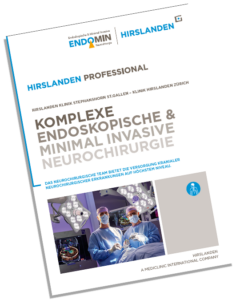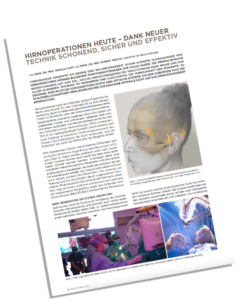HYDROCEPHALUS & CYSTS
TOO MUCH WATER IN THE HEAD
Hydrocephalus occurs when there is a disturbance in the outflow of brain fluid, which builds up at the expense of the space available to the brain within the skull. If the absorption of CSF is disturbed, for example due to bleeding, infection or age, malresorptive or communicating hydrocephalus will develop. Where there is a blockage in CSF from the cerebral ventricles, this is called obstructive hydrocephalus or hydrocephalus occlusus.
Brain cysts are benign changes that are often found by chance. However, pressure on the surrounding brain tissue can cause a CSF circulation disorder, epileptic seizures or neurological failures.
At our centre, we treat all kinds of hydrocephalus and brain cysts. Through our close interdisciplinary cooperation with neuroradiologists, oncologists and radiologists in the ENDOMIN NETWORK, we can provide treatment based on the latest medical findings using all available methods.
In the following sections you will find information about the most important forms of hydrocephalus and brain cysts, their symptoms, diagnostics and treatment options as well as explanations about special techniques and treatment strategies used at our centre.
MALRESORPTIVE HYDROCEPHALUS
The production and absorption of cerebral fluid is normally kept in equilibrium. If too little fluid is absorbed, hydrocephalus can develop. Obstacles to absorption are usually the result of meningitis or a congenital or early-childhood malformation of the brain. Haemorrhages in the cerebral fluid spaces are also possible, most often after an aneurysmal subarachnoid haemorrhage.
Malresorptive hydrocephalus usually causes chronic symptoms that develop slowly, sometimes for years. Typical symptoms are an unsteady gait (small steps and broad-based), brain dysfunction (forgetfulness, slowness, increased irritability) and bladder and faecal incontinence.
Dizziness, concentration disorders, changes in personality, behavioural abnormalities (restlessness, reluctance, impatience) and noise sensitivity may occur. As the symptoms are unspecific, the diagnosis can often takes years. The symptoms may, especially in elderly patients, simulate the onset of dementia. If left untreated, hydrocephalus can lead to severe functional deficits due to irreversible nerve cell damage.
If the clinical examination reveals any conspicuous symptoms, a CT or magnetic resonance (MRI) imaging examination will be performed: it will always show an expanded and dilated ventricular system.
If a chronic malresorptive hydrocephalus is suspected, a CSF drainage test, also called a tap test, will often be carried out. 30-40 ml of cerebrospinal fluid is removed by means of a lumbar puncture in the spinal canal. Standard neurological tests will be performed before and after the puncture. The tests will concentrate on the gait and neuropsychological functions. If there is a
significant improvement, there is hope that surgery can bring about lasting relief from the symptoms.
With malresorptive hydrocephalus, the excess cerebral fluid is discharged from the enlarged brain chambers into another body cavity and a shunt is inserted. The shunt consists of a central catheter in the ventricles, an adjustable shunt valve and a peripheral drain catheter. It is standard procedure for a derivation to be made into the abdomen; this is known as a ventriculo-peritoneal shunt. In some cases, an outlet in front of the right atrium may also be necessary (ventriculo-atrial shunt).
At our centre, when treating malresorptive hydrocephalus, the positioning of the ventriculoperitoneal shunt will be checked with an endoscope. During the navigation-based puncture of the cerebral ventricle, the optimal position of the central catheter is checked with a millimetre-thin “shuntscope”. The peripheral drainage catheter is guided into the abdominal cavity under the control of the abdominal laparoscopy. This dispenses with the need for a larger abdominal opening (laparotomy) and significantly reduces the stress of the operation. The endoscopic assistance guarantees the optimal positioning of the shunt, and allows for reliable checking of functioning.
OBSTRUCTIVE HYDROCEPHALUS
With obstructive hydrocephalus, the cerebral fluid cannot flow out of the inner cerebral fluid ventricles into the outer spaces. The most common cause is a membranous obstruction in the aqueductus cerebri, between the third and fourth ventricles. In rarer cases, the CSF pathways are obstructed by tumours or bleeding.
A membranous aqueduct obstruction is often congenital, so the symptoms develop slowly and gradually. Acute hydrocephalus occurs when the connection between the individual CSF spaces is suddenly blocked by a tumour or a bleed, and the cerebral fluid cannot drain off. The typical symptoms of sudden occlusion hydrocephalus are headache and neck pain (usually in the morning, initially), nausea and vomiting, and disturbed vision. There is a rapid increase in symptoms, frequently with tragic dynamics and clouding of consciousness. Such cases of acute obstruction of the CSF pathways can be life threatening.
In the case of typical symptoms, an MRI will be performed, which always shows an expanded ventricular system. In the usual T1 and T2 MRI sequences, tumours may present, which hinder the circulation of cerebrospinal fluid. With the CISS and flow-sensitive sequences, septations and the pulsatile flow of cerebral fluid may be present.
With obstructive hydrocephalus, there is an obstacle to the CSF leaving the ventricular system and the circulation is “mechanically” disturbed. The most common cause is a narrowing or blockage of the aqueductus cerebri. This canal connects the third and fourth ventricles, and is the “Achilles heel” of the cerebral fluid circulation.
Where there is obstructive hydrocephalus is present, the cause is eliminated (for example, a tumour is removed) or a bypass is created for the cerebral fluid. This is usually done during a minimally invasive endoscopic procedure. This procedure, known as a ventriculocisternostomy, is one of the specialities of our practice.
With obstructive hydrocephalus, a ventriculocisterostomy procedure is performed. The floor of the third ventricle is opened using an endoscope, to create a bypass circuit for the CSF within the cerebral fluid system. The endoscope is introduced into the cerebral ventricles via a borehole trepanation; the optimum entry point and trajectory are defined with the aid of a navigation device. As the cerebral ventricles are filled with clear nerve fluid, there is a good view of the anatomical structures.
In rare cases, with a membranous obstruction, even the aqueduct can be opened and expanded under endoscopic view. This procedure, known as an aqueductoplasty, is more complex and carries a higher risk. It will only be performed if a ventriculociternostomy is not possible due to anatomical conditions.
ARACHNOID CYSTS
Arachnoid cysts are caused by a congenital duplication of the soft meninges. These harmless cavities are filled with cerebrospinal fluid. They can occur anywhere in the cranial cavity. Most often, they are located between the frontal and temporal lobes of the brain, in the sylvian fissure.
Arachnoid cysts are most commonly found by chance. If the cyst is causing symptoms (headaches and epileptic seizures), these are due to the pressure of the cyst on the surrounding brain tissue.
In children, a disproportionate increase in the size of the head is possible, since the skull is not yet ossified.
Because of the good soft-tissue representation, nuclear spin tomography (MRI) is the examination method of choice. Using special thin-slice techniques, the individual architecture of the cyst and its relationship to the surrounding structures can be assessed. The flow of CSF in the cyst can be represented in flow-sensitive images. In special cases, the connection between the cyst and the basal outer cerebral fluid spaces will be investigated with contrast-agent enrichment of the cerebral fluid.
There is only an indication for surgery in the case of symptomatic arachnoid cysts. The aim of the surgical procedure is “windowing”: a connection is established between the cyst and the cerebrospinal fluid spaces to normalise the circulation of cerebrospinal fluid.
In the case of asymptomatic arachnoid cysts discovered by chance, no therapy is usually necessary. However, imaging follow-up checks can be useful in some cases.
At our centre, arachnoid cysts are operated on using endoscopic techniques. The advantage of this method is that the surgeon opens the cyst “under water”. If a cyst is operated on using the classic microsurgical technique, there is a risk that the cyst will collapse together with the neighbouring cerebral cortex, after the cyst contents have been suctioned out. This can lead to serious complications due to the detachment of superficial veins. Draining the cyst fluid into the abdominal cavity (a shunt operation) is now only offered in exceptional cases.
COLLOID CYSTS
Colloid cysts typically occur in the anterior upper region of the third cerebral fluid ventricle. They are benign cystic structures, but due to the blockage of the connection between the lateral ventricles and the third ventricle (foramen monroi) they can lead to obstructive hydrocephalus and thus also become life-threatening.
The typical symptoms such as headaches, nausea, vomiting, balance disorders or limitations in concentration and memory, are caused by a chronic increase in intracranial pressure, due to disrupted cerebral fluid circulation.
If there is an acute increase in brain pressure due to the obstruction of CSF pathways, it can lead to impaired consciousness and even coma. This is a life-threatening situation which can be fatal.
Due to the clinical symptoms, the first step is often a computed tomography (CT) scan, as it is a short examination. In this case, the cyst typically presents as a hyper- or hypodense lesion on the roof of the third ventricle, possibly with accompanying signs of disturbed cerebral fluid circulation (enlarged cerebral fluid spaces).
In order to accurately represent the cyst, a nuclear spin tomography (MRI) will be carried out if possible. The thin-layer representation enables a detailed analysis of the cyst’s architecture and that of the adjacent structures, to allow for an individualised decision on treatment of the patient, and precise surgical planning.
Smaller, asymptomatic colloid cysts that do not cause cerebrospinal fluid circulation disorders should be monitored by imaging (MRI) at regular intervals to assess their size and shape over time.
Cysts that become symptomatic due to impaired circulation of the cerebrospinal fluid should be operated on as soon as possible. Removal of the cyst is also indicated if the images already show evidence of impaired cerebral fluid circulation, but no symptoms have yet occurred, since an acute obstruction of the CSF pathways due to the sudden build-up of cerebral fluid can have fatal consequences. Several case reports of sudden loss of consciousness in patients with previously undetected colloid cysts suggest that preventive surgery is useful.
In principle, two surgical procedures are available. On the one hand, a colloid cyst can be removed microsurgically, via a craniotomy (opening of the skull): this has long been regarded as a standard treatment, but it is complex from a surgical point of view. At our centre, we prefer a minimally invasive, purely endoscopic procedure.
A special endoscope is inserted into the anterior part of the lateral cerebral ventricle. The optimal access is planned with the help of neuronavigation. In this way, the colloid cyst can be removed under purely endoscopic view using millimetric instruments (endoscopic scissors, forceps, coagulation electrodes and suction catheters).
The advantage of the endoscopic method is that less brain tissue is damaged by the endoscopic access than in the case of open surgery. The access through the skull is also significantly smaller (borehole instead of craniotomy).
In the past, a shunt with ventricular drainage on both sides was often applied to a symptomatic colloid cyst, thus eliminating the build-up of cerebral fluid. This technique is now obsolete, because the cause can be treated with minimally invasive techniques.
INTRAVENTRICULAR CYSTS
Intraventricular cysts usually form from the membranes of the soft meninges or cells of the ventricular wall. These cysts are never malignant, but can have serious consequences due to a disturbance in the circulation of cerebral fluid.
Although the cysts are usually congenital, the typical symptoms usually only appear in adulthood, as a result of chronically elevated brain pressure. The typical but partially unspecific symptoms are headache, nausea, vomiting, balance disorders or impairments in concentration and memory.
The examination method of choice is nuclear spin tomography (MRI). Using T2 thin-film techniques, the cyst and its relationship to the surrounding structures can be assessed. The flow of CSF in the cyst can be represented in flow-sensitive images.
Randomly detected smaller cysts, which do not cause a disturbance of the cerebral fluid circulation, do not require surgical therapy and are usually radiologically controlled with MRI. Space-occupying symptomatic cysts must be surgically treated, as a disturbance in the flow of CSF fluid can cause progressive and dangerous symptoms.
The previous treatment for symptomatic brain cysts was to create a shunt and drain off the excess cyst fluid into the abdominal cavity. This technique is outdated today. At our centre, ventricular cysts are operated on using purely endoscopic techniques. The aim of the operation is to “window” the cyst and restore the circulation of cerebral fluid. The endoscope is navigationally guided into the cerebral ventricle, and the cyst wall is opened wide – the positioning of a shunt is no longer necessary.
PINEAL CYSTS
Pineal cysts are benign cystic structures that arise from the pineal gland. If they are bigger than a certain size, there will be a narrowing of the adjacent aqueduct (the connection between the 3rd and 4th ventricles) with a disruption of the flow of CSF and the development of obstructive hydrocephalus. In images, pineal cysts can sometimes be hard to distinguish from tumours of the pineal gland.
The first symptoms such as headaches, nausea, vomiting, visual or balance disorders, usually appear in young adulthood. In many cases, the symptoms occur periodically. Often, however, pineal cysts are discovered by chance and are not responsible for the symptoms that led to the imaging.
Magnetic resonance imaging (MRI) is the imaging method of choice, since both the cyst and the aqueduct can be accurately assessed. In particular, the sagittal, thin-layer sequences are important in order to show any compression of the aqueduct.
Asymptomatic pineal cysts, which are small and do not cause cerebrospinal fluid disturbances, should be monitored regularly by cerebral imaging (MRI). Symptomatic cysts that cause cerebrospinal fluid circulation disorders should be operated on.
In principle, two surgical procedures are available. In the case of an expanded ventricular system, we prefer the purely endoscopic microsurgical technique; in the case of narrow cerebral ventricles, we prefer the endoscopically-assisted microsurgical technique. With the purely endoscopic technique, the operation is carried out “from the front”, via a drill hole created in the forehead/hairline. After navigation-assisted insertion of an endoscope into the third cerebral ventricle, the pineal cyst is opened and windowed endoscopically, and a tumour can be biopsied or removed. If the cerebral ventricles are narrow, the cyst will be opened and removed microsurgically via an access “from the rear”, between the cerebellum and the cerebellar tentorium, in a seated position. In this case, a keyhole access is made at the back of the head and the cyst is reached through open surgery using an endoscopically-assisted technique. Both methods have their justification and must be applied individually according to the anatomical conditions.
Contact
+41 44 387 28 29
Treatment Request
Happy Patients


Questions and Answers
about endoscopic neurosurgery



